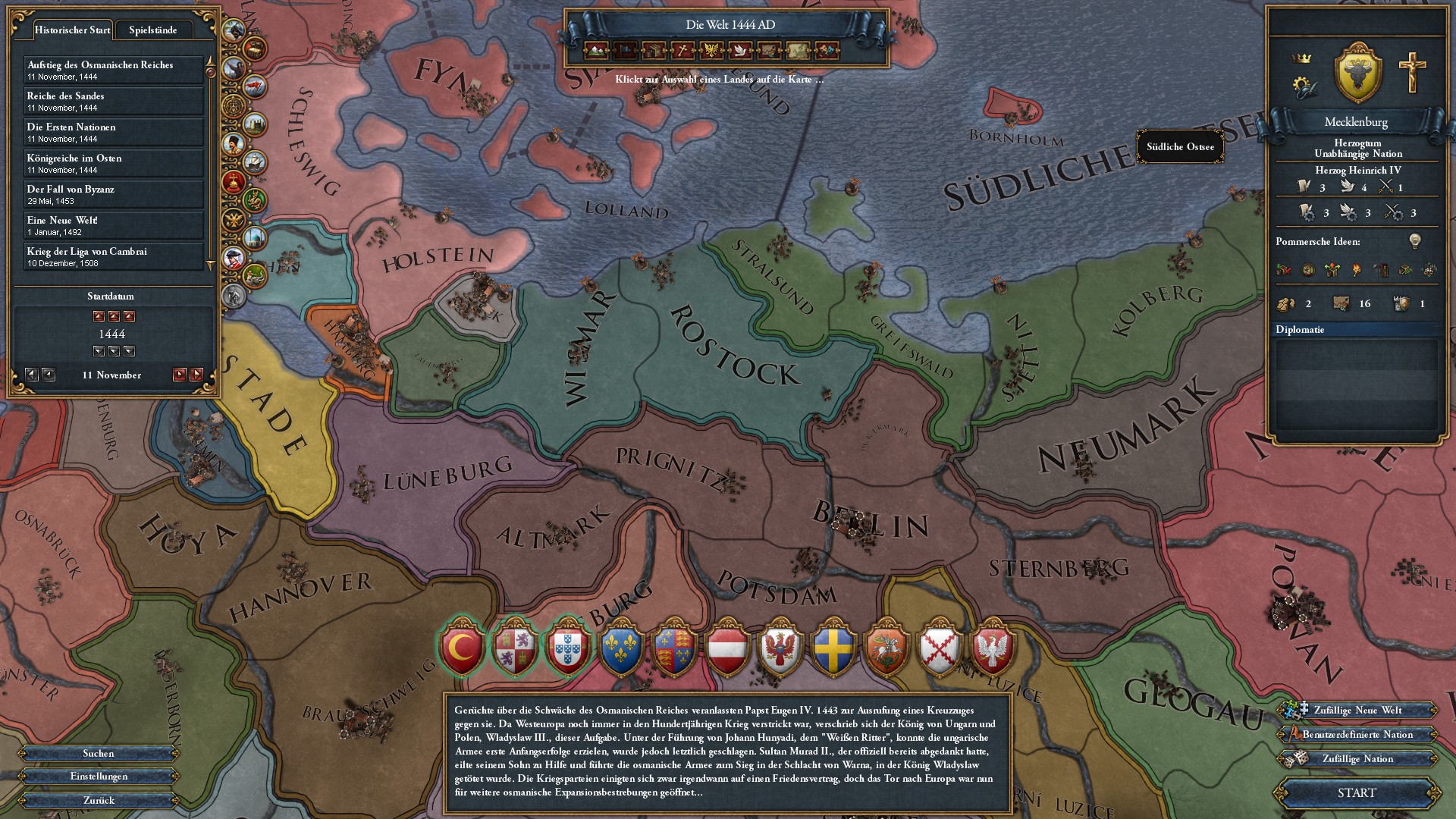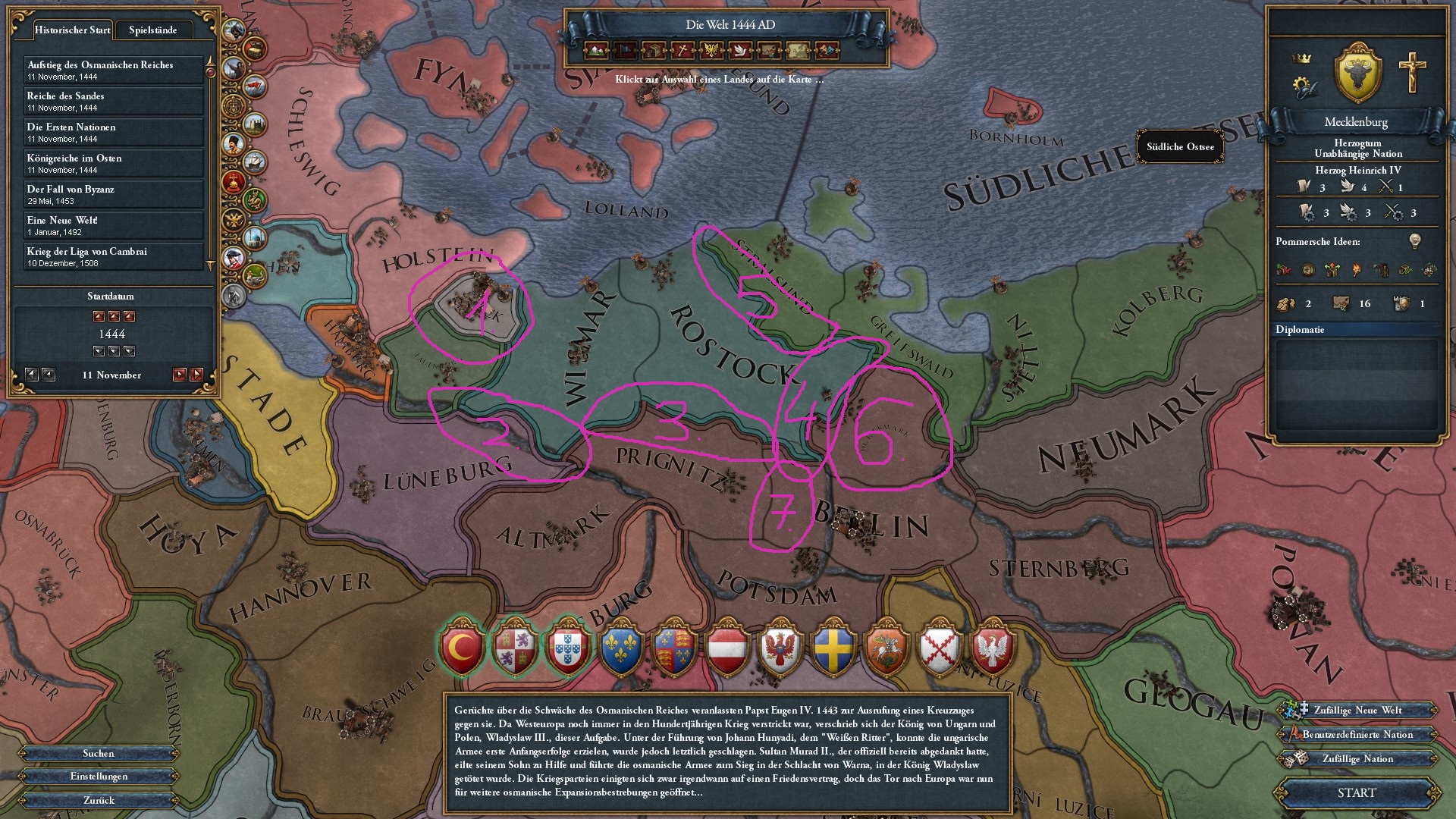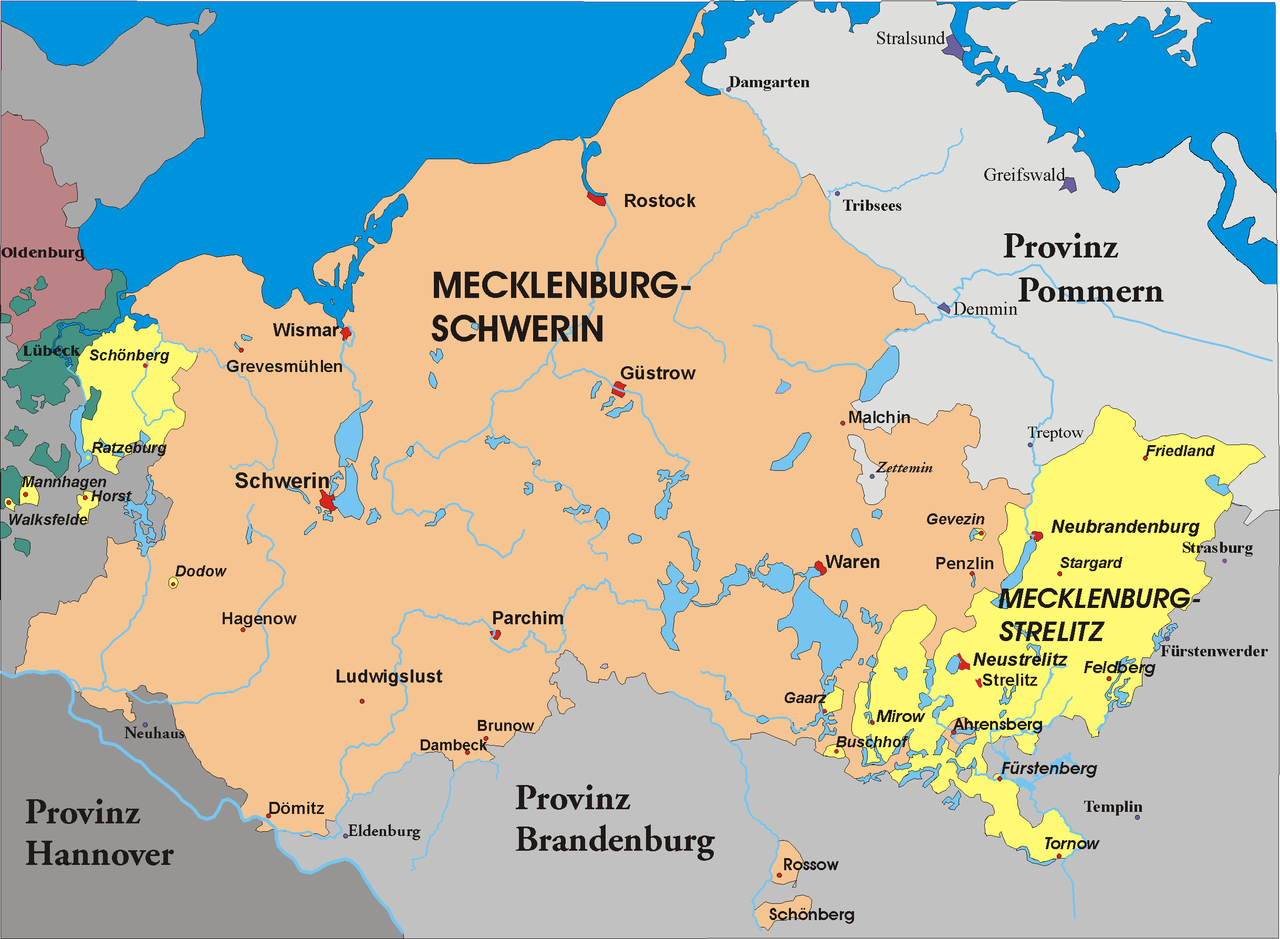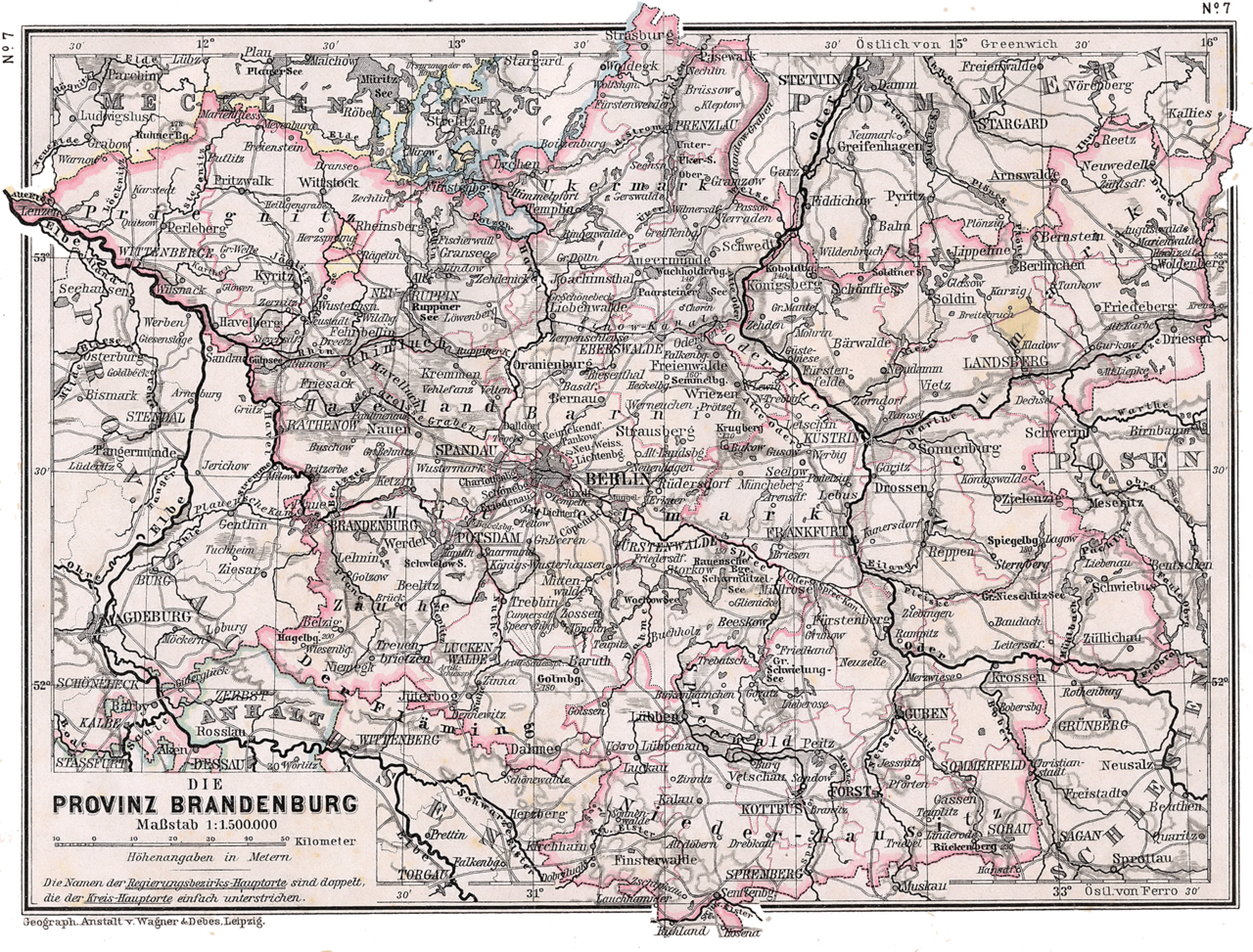Hi there and welcome to another dev diary for EU4. I am Pierre, I’ve been part of the EU4 Content Design team since December, and I feel honoured to be able to give you your first peeks at the new content we are making for the big European update and expansion we have planned for the end of the year.
This is the first of several dev diaries that will focus on the map changes we have made, giving large parts of the European map a much-needed revamp. I’ll be starting with Germany (which for purely arbitrary reasons shall for today include Switzerland and Bohemia, but not Austria). As @neondt stated in an earlier dev diary, our aim was not to recreate Voltaire’s Nightmare or to populate the entire HRE map with OPMs (this would have been eminently possible) but rather to create more depth and more interesting gameplay situations within it, righting various wrongs and finding ways to better represent the various dynamics of the empire’s territories along the way.
As with previous patches, all map changes shown here will be part of the free patch. In previous map previews, we have often revealed the idea groups of the new tags, and rest assured we will be adding new ideas to replace the generic German ones. However, the work to do so still lies in the future, so in the meantime I’d just like to give a shoutout to this thread – if you want to know what we are looking for in terms of threads suggesting new idea groups, look no further.
So without further ado…
South Germany

The lack of primogeniture in Bavaria until the 1500s led to several splits of the Duchy in the 14th century before its reunification in 1503. At game start, Wittelsbach Bavaria is divided between Munich, Landshut and Ingolstadt, who will have to fight it out for the duchy (or hope they inherit it). However, Bavaria can console itself with the fact that, once united, it will have considerably more resources at its disposal than in 1.28, with new provinces in Innbaiern (modern Innviertel, ceded to Austria in 1779; capital: Braunau), Freising, Rosenheim and Donauwörth (which has Swabian culture and is a releasable tag). We hope for Bavaria to become a strong power within the HRE in the next patch. To make this more likely, we will be adding DHEs such as this one to the Bavarian sub-duchies:

Also new to Bavaria is the inclusion of Regensburg as a Free City and Passau as a Bishopric. At present, the latter is a vassal under Munich, since historically Munich’s territories more or less surrounded Passau and we do not wish the latter to be easy food for Bohemia or Austria. Finally, Salzburg (already in the Bavarian geographic area) now has Bavarian culture, which more correctly represents its situation in 1444 – it was part of the Bavarian Circle and was only annexed by Austria as late as 1805.
Moving south, the large province of Tirol has been split in several pieces, with the independent County of Bregenz (currently Austrian culture) to the west representing one of the more challenging starting positions in the HRE (they have 5 development and an heir with low legitimacy). The main province has been further split between Inntal (capital: Innsbruck) and Etschtal (capital: Meran).
Switzerland, too, has seen a makeover. The Swiss Confederacy was a growing power in the 15th century but was not yet close to controlling all of what would become Switzerland. Whilst we elected not to start with individual independent Swiss Cantons (this would simply make them easy prey for Austria, Milan, Savoy and Burgundy), we did split off the largest independent force, the Three Leagues. In the process, Graubünden was split to become Illanz and Chur, and Fribourg/Freiburg was added west of Bern.
Finally, Swabia has seen considerable changes. Firstly, Austria’s holdings in Swabia (or “Further Austria” are better represented, with Breisgau now being ruled by Austria, as it was in history. Baden has been compensated with the addition of Durlach (which would later become Karlsruhe) to its north. Wurttemberg, which was the largest territorial state in Swabia but somehow is an OPM with 6 development in EU4, now has a new province in the form of Urach (capital: Reutlingen) and a substantial buff in terms of development. Additionally, Ravensburg has been swapped for the Free City of Konstanz, Alsace is now the Bishopric of Strasbourg, the new tag of Mulhouse has been added to represent the Decapolis in southern Alsace, and Ulm is no longer wildly mislocated.
To add a bit more interest to the area, states of Swabian culture will now be able to form Swabia.
Central Germany and Bohemia

Saxony has been given several new provinces but has also been split in two. Like Bavaria, Saxony did not have primogeniture; unlike Bavaria, Saxony never fully resolved this issue. As a result, in the 15th century, it was split several times, with the end result being the Treaty of Leipzig in 1485, where Saxony was split between the two brothers Ernest and Albert on lines similar to those displayed on the map above, except that both continued calling themselves Saxony and Ernest (Thuringia) gained Wittenberg and the Electorate. Thuringia/Ernestine Saxony later lost the Electorate to (Albertine) Saxony and split into many, many pieces. This all lies in the future in 1444 (via several planned DHEs), so the current division is based on that in 1445 between the brothers Friedrich and Wilhelm. Thuringia starts under PU by Saxony, but there will be several events which will make it a difficult subject to keep quiet for Saxony. New provinces are Zwickau in Saxony and three in Thuringia (previously one province with low development), which is now much better represented by Erfurt (Mainz has a core on this province to represent certain historical complexities), Weimar and Coburg (Franconian culture).
Franconia has seen a few more provinces and tags added. Most importantly, Franconia itself is now a formable tag if you manage to unite the Franconian lands. This is however easier said than done as Franconia now includes two Free Cities and lands owned by strong neighbours (i.e. Coburg by Thuringia). Würzburg, the titular holders of the duchy, remain the strongest power, with a new province in Fulda (Rhenish i.e. Hessian culture) and vassal in Bamberg. Their main rivals, Ansbach, now have Bayreuth as their junior partners in PU. They are now also bordered on the west by Rothenburg, another new Free City. Finally, the large province of Mainz has been split and the new Franconian culture province of Aschaffenburg has been added.
Moving West, @Ofaloaf did some pyrotechnics to the lower Rhineland map to make space to squeeze in Jülich (owned by Berg). The Palatinate has a new province in Zweibrücken, and although Hessen has no new provinces, its provinces have been renamed to Oberhessen and Niederhessen, with Niederhessen (Kassel) now the capital and more affluent province.
Finally, Bohemia, like other regions, has gained some new provinces. Lusatia has been split in three (with Oberlausitz split between Bautzen and Görlitz). This has allowed us to make Lusatia an area and releasable tag, with the provinces now having Sorbian culture. Silesia, as you can see, has been split in two between Glogau and Opole. Silesia the tag still exists and can be formed by a Silesian country that owns all of Silesia and is not a subject. Bohemia and Moravia have seen three more provinces added, with space being made for Jindrichuv Hradec, Pardubice and Ostrava. Although this is quite a few new provinces, we split the development of existing provinces to make room for them, so Bohemian starting development is not noticeably higher; we will of course be paying attention to the balance side of things to avoid Bohemia becoming the Ottomans of Europe.
Northern Germany

We restrained ourselves from adding too many provinces to Brandenburg, mainly because this was not a very densely inhabited area and in 1444 few would have predicted that it would later rise to power. However, they did gain a new province in Brandenburg (the city) and are stronger than most of their neighbours, so if they can secure the alliances needed to keep the likes of Bohemia away, they are still well-placed to expand – especially since the sale of Neumark will now also grant them Dramburg.
Pomerania had a bit of a situation with their lack of primogeniture too (I seem to be repeating myself here). In fact, they split many, many times and were united much more seldom than they were divided. We went for a fairly conservative split and made them into Wolgast in the west and Stettin in the east, with new provinces in Wolgast and Rügen. A united Pomerania will of course be able to form Pomerania. Also, Rügen is a releasable tag that, in homage to Klaus Störtebecker and the hotbed of piracy that was the Baltic, will have the opportunity of going pirate if you own Golden Century.
The smaller states to the west of Brandenburg have each gained provinces, with Mecklenburg now correctly owning Stargard, Lüneburg’s significance better represented by the addition of Celle, and Magdeburg now owning the bishop’s summer residence of Halle. Braunschweig (previously one of the largest provinces of the HRE) has had the city of Göttingen split off it to the south (still owned by the Brunswick tag though) and is bordered to the east by the new Free City of Goslar, and the tag Verden now also owns a province called Verden as well as Stade.
Further west, Cologne too has an extra province in Paderborn (which is a releasable tag) and Berg is our new bordergore galore tag, owning Bielefeld as well as Berg and Jülich. Last but not least, Dortmund has also been added as a Free City.
Another change that we made in the north is in the cultures. There have been many calls for a “Lower Saxon” culture, and we have heeded these calls by splitting the Westphalian culture. Conveniently, this allows us to make the Kingdom of Hannover into the formable for the Lower Saxons and Westphalia into that for the Westphalians and Rhenish peoples.

As a final note, I’d add that our focus on the Holy Roman Empire gives us a good opportunity to add flavour events for the tags populating it. I’ve been loving reading through the suggestions in threads such as this one. Please keep them coming, and if there is any interesting historical event you would like to see in the game, feel free to ping me (I can also read German and French, so you can send me links in those languages too).
That’s it for now. Next week, I’ll be presenting a few of the German mission trees we have prepared so far.
This is the first of several dev diaries that will focus on the map changes we have made, giving large parts of the European map a much-needed revamp. I’ll be starting with Germany (which for purely arbitrary reasons shall for today include Switzerland and Bohemia, but not Austria). As @neondt stated in an earlier dev diary, our aim was not to recreate Voltaire’s Nightmare or to populate the entire HRE map with OPMs (this would have been eminently possible) but rather to create more depth and more interesting gameplay situations within it, righting various wrongs and finding ways to better represent the various dynamics of the empire’s territories along the way.
As with previous patches, all map changes shown here will be part of the free patch. In previous map previews, we have often revealed the idea groups of the new tags, and rest assured we will be adding new ideas to replace the generic German ones. However, the work to do so still lies in the future, so in the meantime I’d just like to give a shoutout to this thread – if you want to know what we are looking for in terms of threads suggesting new idea groups, look no further.
So without further ado…
South Germany

The lack of primogeniture in Bavaria until the 1500s led to several splits of the Duchy in the 14th century before its reunification in 1503. At game start, Wittelsbach Bavaria is divided between Munich, Landshut and Ingolstadt, who will have to fight it out for the duchy (or hope they inherit it). However, Bavaria can console itself with the fact that, once united, it will have considerably more resources at its disposal than in 1.28, with new provinces in Innbaiern (modern Innviertel, ceded to Austria in 1779; capital: Braunau), Freising, Rosenheim and Donauwörth (which has Swabian culture and is a releasable tag). We hope for Bavaria to become a strong power within the HRE in the next patch. To make this more likely, we will be adding DHEs such as this one to the Bavarian sub-duchies:

Also new to Bavaria is the inclusion of Regensburg as a Free City and Passau as a Bishopric. At present, the latter is a vassal under Munich, since historically Munich’s territories more or less surrounded Passau and we do not wish the latter to be easy food for Bohemia or Austria. Finally, Salzburg (already in the Bavarian geographic area) now has Bavarian culture, which more correctly represents its situation in 1444 – it was part of the Bavarian Circle and was only annexed by Austria as late as 1805.
Moving south, the large province of Tirol has been split in several pieces, with the independent County of Bregenz (currently Austrian culture) to the west representing one of the more challenging starting positions in the HRE (they have 5 development and an heir with low legitimacy). The main province has been further split between Inntal (capital: Innsbruck) and Etschtal (capital: Meran).
Switzerland, too, has seen a makeover. The Swiss Confederacy was a growing power in the 15th century but was not yet close to controlling all of what would become Switzerland. Whilst we elected not to start with individual independent Swiss Cantons (this would simply make them easy prey for Austria, Milan, Savoy and Burgundy), we did split off the largest independent force, the Three Leagues. In the process, Graubünden was split to become Illanz and Chur, and Fribourg/Freiburg was added west of Bern.
Finally, Swabia has seen considerable changes. Firstly, Austria’s holdings in Swabia (or “Further Austria” are better represented, with Breisgau now being ruled by Austria, as it was in history. Baden has been compensated with the addition of Durlach (which would later become Karlsruhe) to its north. Wurttemberg, which was the largest territorial state in Swabia but somehow is an OPM with 6 development in EU4, now has a new province in the form of Urach (capital: Reutlingen) and a substantial buff in terms of development. Additionally, Ravensburg has been swapped for the Free City of Konstanz, Alsace is now the Bishopric of Strasbourg, the new tag of Mulhouse has been added to represent the Decapolis in southern Alsace, and Ulm is no longer wildly mislocated.
To add a bit more interest to the area, states of Swabian culture will now be able to form Swabia.
Central Germany and Bohemia

Saxony has been given several new provinces but has also been split in two. Like Bavaria, Saxony did not have primogeniture; unlike Bavaria, Saxony never fully resolved this issue. As a result, in the 15th century, it was split several times, with the end result being the Treaty of Leipzig in 1485, where Saxony was split between the two brothers Ernest and Albert on lines similar to those displayed on the map above, except that both continued calling themselves Saxony and Ernest (Thuringia) gained Wittenberg and the Electorate. Thuringia/Ernestine Saxony later lost the Electorate to (Albertine) Saxony and split into many, many pieces. This all lies in the future in 1444 (via several planned DHEs), so the current division is based on that in 1445 between the brothers Friedrich and Wilhelm. Thuringia starts under PU by Saxony, but there will be several events which will make it a difficult subject to keep quiet for Saxony. New provinces are Zwickau in Saxony and three in Thuringia (previously one province with low development), which is now much better represented by Erfurt (Mainz has a core on this province to represent certain historical complexities), Weimar and Coburg (Franconian culture).
Franconia has seen a few more provinces and tags added. Most importantly, Franconia itself is now a formable tag if you manage to unite the Franconian lands. This is however easier said than done as Franconia now includes two Free Cities and lands owned by strong neighbours (i.e. Coburg by Thuringia). Würzburg, the titular holders of the duchy, remain the strongest power, with a new province in Fulda (Rhenish i.e. Hessian culture) and vassal in Bamberg. Their main rivals, Ansbach, now have Bayreuth as their junior partners in PU. They are now also bordered on the west by Rothenburg, another new Free City. Finally, the large province of Mainz has been split and the new Franconian culture province of Aschaffenburg has been added.
Moving West, @Ofaloaf did some pyrotechnics to the lower Rhineland map to make space to squeeze in Jülich (owned by Berg). The Palatinate has a new province in Zweibrücken, and although Hessen has no new provinces, its provinces have been renamed to Oberhessen and Niederhessen, with Niederhessen (Kassel) now the capital and more affluent province.
Finally, Bohemia, like other regions, has gained some new provinces. Lusatia has been split in three (with Oberlausitz split between Bautzen and Görlitz). This has allowed us to make Lusatia an area and releasable tag, with the provinces now having Sorbian culture. Silesia, as you can see, has been split in two between Glogau and Opole. Silesia the tag still exists and can be formed by a Silesian country that owns all of Silesia and is not a subject. Bohemia and Moravia have seen three more provinces added, with space being made for Jindrichuv Hradec, Pardubice and Ostrava. Although this is quite a few new provinces, we split the development of existing provinces to make room for them, so Bohemian starting development is not noticeably higher; we will of course be paying attention to the balance side of things to avoid Bohemia becoming the Ottomans of Europe.
Northern Germany

We restrained ourselves from adding too many provinces to Brandenburg, mainly because this was not a very densely inhabited area and in 1444 few would have predicted that it would later rise to power. However, they did gain a new province in Brandenburg (the city) and are stronger than most of their neighbours, so if they can secure the alliances needed to keep the likes of Bohemia away, they are still well-placed to expand – especially since the sale of Neumark will now also grant them Dramburg.
Pomerania had a bit of a situation with their lack of primogeniture too (I seem to be repeating myself here). In fact, they split many, many times and were united much more seldom than they were divided. We went for a fairly conservative split and made them into Wolgast in the west and Stettin in the east, with new provinces in Wolgast and Rügen. A united Pomerania will of course be able to form Pomerania. Also, Rügen is a releasable tag that, in homage to Klaus Störtebecker and the hotbed of piracy that was the Baltic, will have the opportunity of going pirate if you own Golden Century.
The smaller states to the west of Brandenburg have each gained provinces, with Mecklenburg now correctly owning Stargard, Lüneburg’s significance better represented by the addition of Celle, and Magdeburg now owning the bishop’s summer residence of Halle. Braunschweig (previously one of the largest provinces of the HRE) has had the city of Göttingen split off it to the south (still owned by the Brunswick tag though) and is bordered to the east by the new Free City of Goslar, and the tag Verden now also owns a province called Verden as well as Stade.
Further west, Cologne too has an extra province in Paderborn (which is a releasable tag) and Berg is our new bordergore galore tag, owning Bielefeld as well as Berg and Jülich. Last but not least, Dortmund has also been added as a Free City.
Another change that we made in the north is in the cultures. There have been many calls for a “Lower Saxon” culture, and we have heeded these calls by splitting the Westphalian culture. Conveniently, this allows us to make the Kingdom of Hannover into the formable for the Lower Saxons and Westphalia into that for the Westphalians and Rhenish peoples.

As a final note, I’d add that our focus on the Holy Roman Empire gives us a good opportunity to add flavour events for the tags populating it. I’ve been loving reading through the suggestions in threads such as this one. Please keep them coming, and if there is any interesting historical event you would like to see in the game, feel free to ping me (I can also read German and French, so you can send me links in those languages too).
That’s it for now. Next week, I’ll be presenting a few of the German mission trees we have prepared so far.









